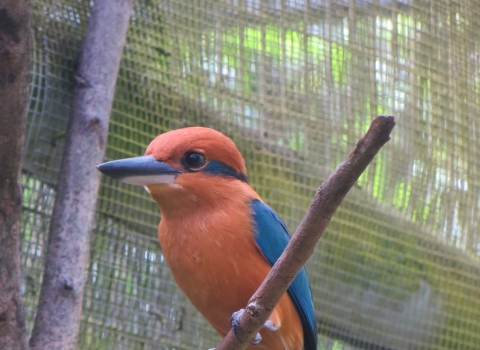(Honolulu, HI) In a historic and collaborative effort to save a species from extinction, 24 critically endangered Nihoa Millerbirds were released on Laysan Island in Papahānaumokuākea Marine National Monument on September 10. The release was the result of many years of research and detailed planning by biologists and resource managers, led by a partnership between the U.S. Fish and Wildlife Service (FWS) and American Bird Conservancy (ABC).
Millerbirds have been absent from Laysan for nearly 100 years after a closely related subspecies went extinct in the early 20th Century. As part of a decades-long restoration effort, this translocation restores this insect-eating songbird to Laysan’s ecosystem.
“This project, which restores Millerbirds to Laysan Island, will reduce the chances that catastrophic events such as hurricanes or the introduction of invasive predators will extirpate the species, since there will be independent populations of Millerbirds on two islands, 650 miles apart,” said Loyal Mehrhoff, Field Supervisor for the Pacific Islands Fish and Wildlife Office.
“It is thrilling to see Millerbirds back on Laysan once more, not simply because they have been a missing piece of the island’s native ecosystem for so long, but also because this marks a potential turning point in the recovery of the species,” said George Wallace, ABC’s Vice President for Oceans and Islands. “It is hard to imagine a project of this complexity going any more smoothly. From the capture of birds on Nihoa, the three-day trip to Laysan, and finally the release of birds. We have subsequently re-sighted all of the radio-tagged birds on Laysan and several of the others; all are looking healthy and behaving normally – a very encouraging sign for the future,” he said.
Biologists from FWS and ABC, avian husbandry experts, and a wildlife veterinarian took special care to ensure the safe transport and arrival of the Millerbirds at Laysan after their three-day voyage from Nihoa.
The birds were kept in specially designed cages for 6 days between their capture on Nihoa and their release on Laysan. Each bird carries a unique combination of colored leg bands to allow identification in the field, and half the birds were fitted with temporary radio transmitters so that their locations can be determined during their first three weeks in their new home. Biologists will remain on Laysan for the next year to monitor the birds’ movements and behaviors, including, the team hopes, their first nesting attempts.
“Translocation is an important tool for the conservation of endangered island birds, and the Millerbird translocation stands on the shoulders of previous efforts,” said Holly Freifeld, biologist with the Fish and Wildlife Service. “This project also breaks a lot of new ground, and has been a model of teamwork and innovation for the past five years. Twenty-two people – the Millerbird team, the crew of the M/V Searcher, and the FWS restoration team on Laysan – worked very hard and with high energy and spirits to make this trip a success.”
The Millerbird, which weighs less than an ounce, is a lively brown song bird that forages for insects among low shrubs and bunch-grasses. On Laysan, the Millerbird joins other endangered species, such as the Laysan Finch, Laysan Duck, Hawaiian monk seal, and several plant species, as well as millions of nesting seabirds.
At 1,023 acres Laysan is the second largest of the Northwestern Hawaiian Islands, and is located in the Papahānaumokuākea Marine National Monument, approximately 790 miles northwest of Honolulu.
As a co-manager of the Papahānaumokuākea Marine National Monument, the FWS is proud to lead this project in collaboration with American Bird Conservancy. We are grateful for the support from the National Fish and Wildlife Foundation through their Hawai‘i Forest Bird Keystone Initiative, the University of New Brunswick, University of Hawai‘i, Pacific Rim Conservation, the USGS National Wildlife Health Research Center, and the Office of Hawaiian Affairs.
To learn more about the Millerbird project, visit: www.papahanaumokuakea.gov/ and www.abcbirds.org/abcprograms/oceansandislands/hawaii.html.
Papahānaumokuākea is cooperatively managed to ensure ecological integrity and achieve strong, long-term protection and perpetuation of Northwestern Hawaiian Island ecosystems, Native Hawaiian culture, and heritage resources for current and future generations. Three co-trustees - the Department of Commerce, Department of the Interior, and State of Hawai‘i - joined by the Office of Hawaiian Affairs, protect this special place. Papahānaumokuākea Marine National Monument was inscribed as the first mixed (natural and cultural) UNESCO World Heritage Site in the United States in July 2010. For more information, please visit www.papahanaumokuakea.gov
Note to Editors: Images are available by calling Ken Foote at 808-792-9535.
Release of Nihoa Millerbirds on Laysan Island Offers New Hope for Critically Endangered Species


